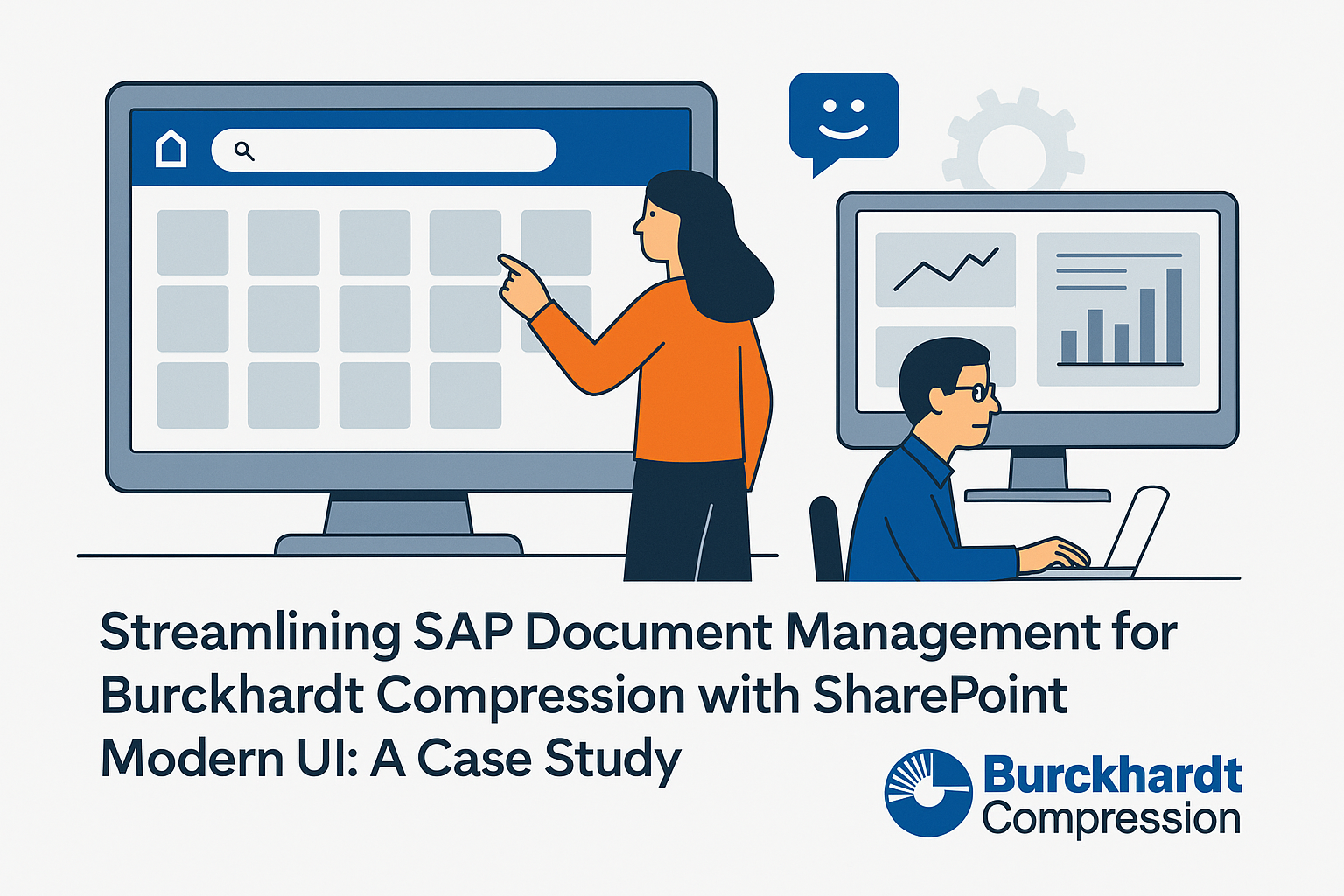
The Document Management Integration Challenge
Burckhardt Compression, a global leader in reciprocating compressor solutions for industrial and energy applications, faced a common challenge in organizations running SAP: critical business documents stored in SAP required better accessibility and collaboration capabilities than SAP's native document management provided.
Engineers needed to collaborate on technical specifications. Sales teams required quick access to customer documentation. Operations staff needed integrated access to equipment manuals and maintenance records. SAP stored these documents, but accessing them was cumbersome, collaboration was limited, and the user experience frustrated employees accustomed to modern cloud tools.
The SAP Document Management Problem
SAP excels at transaction processing and structured data management, but document collaboration and content management are not its strengths. Organizations using SAP typically encounter several pain points:
Poor User Experience: SAP's document interfaces feel outdated compared to modern collaboration platforms, leading to user frustration and workaround creation.
Limited Collaboration: Multiple users cannot edit documents simultaneously, version control is manual, and tracking document changes is difficult.
Mobile Access Gaps: Accessing SAP documents from mobile devices is challenging, limiting field and remote workers.
Search Limitations: Finding specific documents across large SAP repositories is time-consuming and often requires knowing exact document numbers or filing locations.
Integration Challenges: Working with SAP documents in Office 365 applications requires downloading, editing, and re-uploading—a workflow that breaks modern collaboration patterns.
The SharePoint Modern UI Integration Solution
We designed and implemented a solution that integrated SAP document management with SharePoint Modern UI, creating a unified experience combining SAP's transaction processing with SharePoint's collaboration capabilities.
Bi-Directional Document Synchronization
The integration synchronized documents between SAP and SharePoint automatically. Documents created or updated in SAP appeared in SharePoint within minutes. Changes made in SharePoint flowed back to SAP, maintaining system-of-record integrity while enabling modern collaboration.
SharePoint Modern UI Experience
Users accessed SAP documents through SharePoint's modern interface—intuitive, mobile-responsive, and consistent with other Microsoft 365 experiences. The transition from SAP's functional but dated interface to SharePoint's modern UI improved user satisfaction dramatically.
Real-Time Co-Authoring
Multiple users edited Word, Excel, and PowerPoint documents simultaneously—impossible within SAP. Changes synchronized in real-time, eliminating version conflict issues that plagued the previous workflow.
Intelligent Search
SharePoint search indexed SAP document content, metadata, and related business context. Users found documents through natural language queries rather than navigating complex folder structures or remembering SAP document numbers.
Mobile Access
The SharePoint mobile app provided full access to SAP documents from any device. Field engineers accessed equipment manuals during service calls. Sales representatives reviewed customer documents during meetings. Executives accessed reports from anywhere.
Integration Architecture
The technical solution balanced several requirements: maintaining SAP as system of record, providing modern user experience, ensuring data security, and enabling real-time collaboration.
Integration Layer
We built custom integration using Azure Functions and Logic Apps connecting SAP and SharePoint:
- Document Event Capture: Azure Functions monitored SAP document library changes through SAP APIs
- Metadata Mapping: Business logic translated SAP document attributes to SharePoint metadata, maintaining business context
- Bi-Directional Sync: Logic Apps orchestrated document flow in both directions with conflict detection and resolution
- Security Mapping: SAP authorization profiles mapped to SharePoint permissions, ensuring consistent access controls
SharePoint Configuration
SharePoint libraries mirrored SAP document structure while enhancing it with modern capabilities:
- Content Types: Defined for each SAP document category with appropriate metadata fields
- Retention Policies: Automated lifecycle management aligned with corporate governance
- Version Control: Comprehensive version history with change tracking
- Modern UI: Clean, intuitive interfaces replacing SAP's functional but complex screens
Security and Compliance
Enterprise document management requires robust security:
- Azure AD Integration: Single sign-on with SAP and SharePoint using same credentials
- Permission Synchronization: SAP authorization profiles mapped to SharePoint security groups automatically
- Audit Logging: Complete access and change tracking meeting regulatory requirements
- Data Classification: Sensitive document protection through Azure Information Protection
Implementation Approach
Phase 1: Assessment and Architecture (Weeks 1-2)
We analyzed Burckhardt's SAP document management configuration, usage patterns, and integration requirements. Key decisions included:
- Which SAP document types to integrate initially vs. later phases
- Metadata mapping between SAP and SharePoint
- Synchronization frequency balancing real-time needs with system performance
- Security model ensuring appropriate access controls
- Change management approach for user transition
Phase 2: Development and Testing (Weeks 3-8)
Development followed an agile approach with iterative deliveries:
Weeks 3-5: Core integration development—SAP connection, document synchronization, metadata mapping, and basic SharePoint configuration.
Weeks 6-7: Advanced features—search optimization, mobile experience, and workflow automation.
Week 8: Integration testing with SAP sandbox environment validating functionality under various scenarios.
Phase 3: Pilot Deployment (Weeks 9-11)
We piloted with the engineering department—heavy document users with diverse needs. Pilot users accessed documents through both SAP (existing workflow) and SharePoint (new experience), providing feedback while building confidence in the integration.
Pilot results validated the approach: 75% reduction in time to find documents, 90% user preference for SharePoint interface, and zero data integrity issues during intensive testing.
Phase 4: Full Rollout (Weeks 12-16)
Based on pilot success, we rolled out across all departments with phased approach by business unit. Each phase included targeted training, support resources, and monitoring to ensure smooth transition.
Results and Business Impact
User Productivity Improvements
70% Faster Document Access: Modern search and intuitive navigation reduced time spent finding documents from minutes to seconds.
50% Reduction in Email Attachments: Real-time co-authoring and document sharing replaced inefficient email-based collaboration.
Mobile Productivity Gains: Field engineers and remote workers gained full document access from mobile devices, previously unavailable.
Elimination of Version Conflicts: Co-authoring and automatic version control prevented the "conflicted copy" problems that plagued previous workflows.
Operational Efficiency
Reduced Support Tickets: Intuitive SharePoint interface required less training and generated fewer help desk requests than SAP document access.
Faster Onboarding: New employees productive with document access on day one through familiar SharePoint interface.
Improved Compliance: Automated retention policies and comprehensive audit trails enhanced regulatory compliance.
Strategic Benefits
Foundation for Digital Workplace: Integration established pattern for connecting SAP with modern collaboration tools, enabling additional integrations.
User Satisfaction: Dramatic improvement in employee satisfaction with document access and collaboration capabilities.
Future-Ready Architecture: Cloud-based integration prepared infrastructure for continued digital transformation.
Technical Lessons and Best Practices
Several technical insights emerged from this integration project:
Metadata Strategy Is Critical: Thoughtful metadata mapping between SAP and SharePoint ensured business context carried over, making SharePoint more than just a document viewer.
Conflict Resolution Requires Business Rules: When users edit in both SAP and SharePoint simultaneously, clear conflict resolution rules prevent data loss or corruption.
Performance Optimization Matters: Large document repositories require careful synchronization design to avoid performance impacts on SAP or SharePoint.
Security Mapping Complexity: SAP's authorization framework differs significantly from SharePoint's permission model. Thorough mapping design prevents security gaps or over-restriction.
User Change Management: Technical integration success means nothing if users continue SAP workflows by habit. Training and communication are as important as technology.
Applicability Beyond Burckhardt
SAP document management integration challenges are common across industries. This approach applies to:
- Manufacturing: Engineering drawings, quality documents, and equipment manuals stored in SAP
- Energy: Safety documentation, maintenance records, and regulatory compliance files
- Distribution: Supplier agreements, logistics documentation, and inventory specifications
- Professional Services: Project documentation, client deliverables, and contract files
Any organization running SAP with significant document collaboration needs can benefit from this integration pattern.
Getting Started with SAP-SharePoint Integration
If your organization struggles with SAP document management—poor user experience, limited collaboration, mobile access gaps, or cumbersome workflows—integration with SharePoint Modern UI provides a proven solution path.
Ready to modernize SAP document management? Contact QueryNow for an SAP integration assessment. We will evaluate your current document management challenges, design an integration architecture, and implement a solution that combines SAP transaction processing with modern SharePoint collaboration capabilities.


